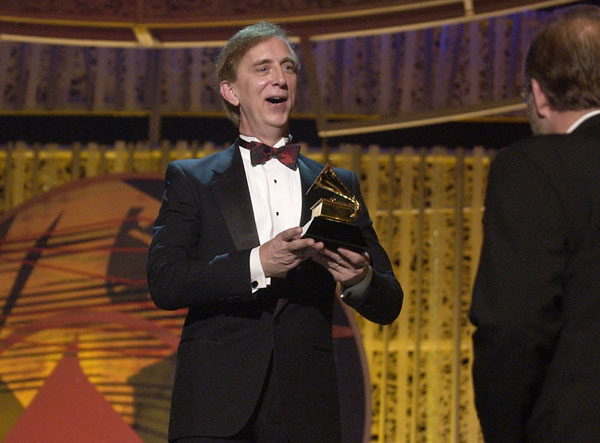(Reprinted with the kind permission of LARADIO.COM) 
For a couple of years Rich Capparela has been helping out as a member of the Grammy Classical selection committee. "That means sitting in a hotel meeting room for a couple of days going through hundreds of submissions to decide if a recording is best categorized as say, chamber music or small ensemble. Male vocal or crossover? That sort of thing," revealed Rich. This year Rich was asked to emcee the 8th annual Classical luncheon at the Biltmore. "The Grammys honored flutist Sir James Galway. After I'd agreed to do that, I got a call asking if I would be interested in just a little bit more. It wound up being a highlight in a 32-year career as a dj. Here's what 'a little bit more' involved: * Pre-recording the 100+ '...and the nominees are...' announcements of the for the pre-telecast. The pre-tel has traditionally been something of an orphan at the Grammys, even though more than 90 of the 100+ awards are given out at it. This year they did it up right. The pre-tel took place earlier in the afternoon at the Convention Center. It featured a live band, a host, eight presenters, graphics, music performance and a stage. In other words, it was a fully produced 2 1/2 hour pre-Grammy show with nominees in attendance. A very cool event. * I got to be one of the eight presenters actually opening the envelopes and getting to say '...and the Grammy goes to...' Evidently they've had some problems in the past with those obscure Classical pronunciations, so having a Classical dj do it worked well for them. For me, it was a chance to stand in front of an audience ranging from Weird Al Yankovic and Ricky Skaggs to The Blind Boys of Alabama and Foo Fighters and hand out a dozen classical Grammys. What a buzz! And what a challenge to reach across to an audience that I knew, for the most part, didn't care all that passionately about who got the best Chamber Music Performance Grammy. A little self-deprecating humor goes a long way in a room like that. To stand in front of that much diverse talent for such a joyous purpose. . . . * Immediately following the Pre-Tel I was whisked up to a room at the Convention Center where I recorded eight or nine sets of recordings announcing all 90+ of the pre-tel winners. I finished about fifteen minutes after the Staples Center telecast began. Then, during the actual CBS telecast when the network went to commercial, screens in Staples Center came down and slides came on with stills of the winners accepting their awards. All the while there was my voice running underneath. It was the loudest I've ever heard my voice played back. I was okay with it. The deal included a pair of tickets for the Grammy show itself. I brought my step-daughter Tehya as my guest. When I finally got to my seat to join her, it turned out to be in row eleven. Row eleven! Tarentino was about five rows ahead and Kenny Loggins was behind us (which, admittedly, says less about me than it does about Kenny Loggins' career these days). Sarah Jessica Parker kept on walking past us, as did Justin Timberlake and Courtney Love. Amazing. Rich concluded his Grammy experience with a lasting memory: "The host for the pre-tel was Steve Vai, one of the greatest living rock guitarists. He played on many Zappa albums and just about anywhere else a band needed the ultimate musician. As we were getting to start the show Steve asked if the scripted introduction of yours truly was okay or if I wanted to add anything. I told him there was one thing. And so he obliged me my introducing me as 'The most awesome guitarist I've ever heard.' That got a laugh." "I've gotten the impression that the Grammy folks might invite me do this again. Let me think about for a moment. Okay," Rich conceded. |
